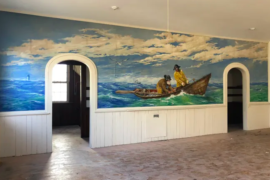Barnstable Patriot, July 19, 2019 The Cape Cod Maritime Museum has launched three new exhibits, including a real-time restoration project that visitors are invited to follow.
“All three of these exhibits are important for different reasons,” says executive director Liz Rabideau. “The surfboat restoration is a real-time restoration project, whose goal is not only to complete our collection of historic Cape Cod wood boats but to also engage the community in the intricate process of restoration. The public is invited to come and see the progress, to ask questions and even to volunteer to help.”
“In addition, we have our new History of Navigation exhibit and an exhibit of the Pilgrims’ journey prior to setting across the Atlantic to the New World,” says Rabideau.
Surfboats – 24-foot wave-faring rowboats – crashed through stormy waters and saved the lives of shipwrecked souls along the outer Cape in the early 1900s. In their 53-year history, only two surfboat rescues ended in crew casualties.
The surfboats were stationed at 13 lifesaving stations along the outer Cape in the early to mid-20th century. One such boat, a 24-ft. Race Point surfboat built in 1944, was gifted to the museum years ago. The iconic boat sat on the museum’s front lawn, a symbol of the Cape’s maritime history, and museum personnel have decide it’s time to restore her.
The Surfboat Restoration exhibit is a real-time restoration project. Throughout the summer, visitors may view the surfboat during the various stages of her restoration and witness first-hand the process of wooden boat restoration over an estimated two-year period.
The second exhibition connects the dots between stick charts, sextants and Nantucket astronomer Maria Mitchell (1818-1889)—all of which play a part in the History of Navigation from 1200 BC. The show chronicles navigation from the ancient Polynesians up until present-day GPS, taking visitors on a journey through time.
As a teen, Mitchell was trusted by sailors to do their navigational computations for their long whaling journeys. She also discovered a comet in 1847.
Explore topics such as longitude and latitude and principles of celestial navigation. Learn the workings of 20th-century electronic equipment, such as a Radio Direction Finder (RDF), Loran and GPS. The real-time Automatic Identification System (AIS) even tracks vessels from the museum right in Hyannis Harbor.
Explore topics such as longitude and latitude and principles of celestial navigation. Learn the workings of 20th-century electronic equipment, such as a Radio Direction Finder (RDF), Loran and GPS. The real-time Automatic Identification System (AIS) even tracks vessels from the museum right in Hyannis Harbor.
Finally, get to know The Pilgrims: Before They Were Here, which is Phase One of the museum’s 400-year anniversary of the Mayflower exhibit.
Before They Were Here chronicles the life of the Pilgrims from 1606 to before their departure for the New World in 1620. Learn in-depth about the circumstances which made them leave England for Holland, and why they finally decided they must set sail for the New World.
The Pilgrims: Before They Were Here will be on display through April 2020.
Museum hours are seven days a week, 10 a.m.-4 p.m. Admission, $10; students, seniors and veterans, $8; active military, free. Visit www.capecodmaritimemuseum.org for more information.



